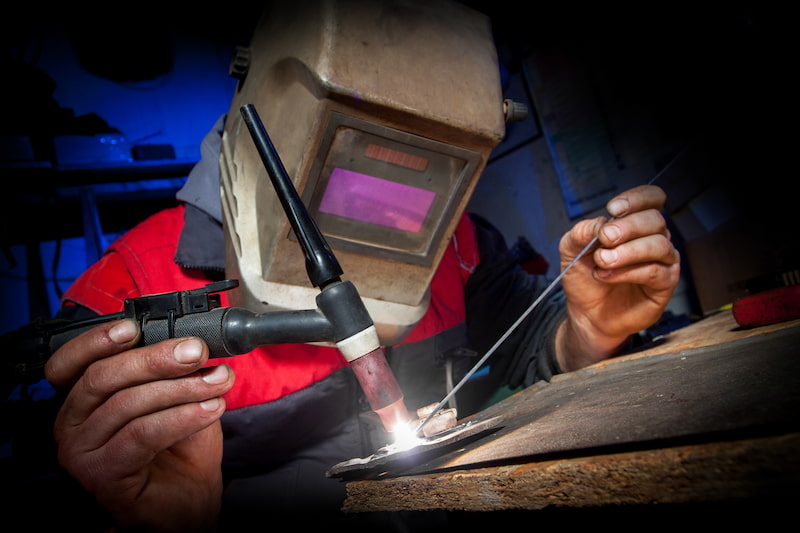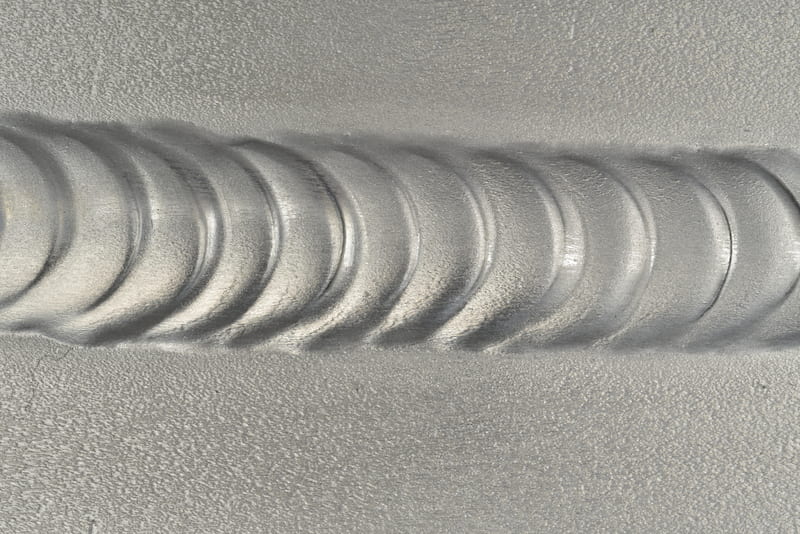Welding aluminium is quite common in the manufacturing and aerospace industries thanks to its unique mechanical properties. Aluminium is lightweight, durable and quite resistant to corrosion, making it an attractive choice for some applications compared to other metals.
Aluminium welding faces a set of unique challenges though, to achieve a successful and defect-free result.
- Aluminium's high thermal conductivity and natural tendency for oxidation require careful preparation and higher heat input to avoid welding defects like warping and porosity.
- Aluminium welding commonly employs TIG, MIG, and other methods like laser and resistance welding, each offering unique benefits for different applications.
- Successful aluminium welding necessitates selecting the right filler material, adjusting welding parameters, and using appropriate shielding gas to prevent contamination and achieve durable welds.
The Challenges in Welding Aluminium
Welding aluminium is a complex process that requires knowledge, skill, and experience. Understanding the different welding processes suitable for aluminium and the challenges and workarounds regarding those methods is paramount for achieving successful welding joints.
Oxidation
Aluminium rapidly oxidises when exposed to the atmosphere, forming a thin oxide layer with a higher melting temperature (2072 C°) than aluminium (660 C°). Welding through this barrier might burn holes through the workpiece.
The oxide layer can be dissolved using solvents or acids before welding the workpiece. It can be physically removed through mechanical abrasive techniques through an exclusive stainless steel wire brush or sandblasting.
Porousness
Aluminium in its molten state, absorbs high amounts of hydrogen, resulting in tiny voids or bubbles forming in the weld metal. This weakens the structural integrity of the metal, making it vulnerable to failure from pressure and stress.
Porosity is minimised by using clean materials and equipment, removing oil and grease from the metal’s surface, and using a shielding gas to limit contamination.
Impurities
Oil, dirt, air and debris can negatively impact the weld zone, affecting the strength and appearance of the workpiece. These impurities can come from multiple sources, such as the environment, equipment, preparation and storage. Discolouration, graining, corrosion and oxidation present signs of impurities in a weld joint.
Proper storage, equipment maintenance and metal preparation are the steps to take to avoid impurities.
Thickness

Working with aluminium typically involves welding materials with varying thicknesses. Welding through a combination of thin and thick material simultaneously can be tricky. Heat applied to the workpiece might melt through the thin material or not penetrate the thick material enough to create a strong weld joint.
A thorough understanding of the aluminium grades, welding methods, and techniques is the key to success in effectively welding different aluminium sheet thicknesses. Welders can effectively weld these metals by setting the parameters such as amperage and heat input to optimal levels.
Hot Cracking
High levels of thermal stress can lead to hot cracking or solidification cracking in aluminium welds. It is one of the reasons why aluminium was once deemed unsuitable for arc welding.
Combining various alloying elements and treating aluminium alloys can drastically improve its mechanical properties. (Al-Cu) 2xxx and (Al-Zn) 7xxx grade series are aluminium alloys that can heat-treated.
Thermal Conductivity
The high thermal conductivity of aluminium makes it challenging to penetrate the weld joint successfully, as it absorbs and dissipates heat quickly.
Adjusting the settings on the welding equipment to higher heat input improves penetration.
Aluminium Welding Methods
Several welding processes are used for aluminium, each having its own strengths and weaknesses. Welders usually choose TIG and MIG welding, yet other methods can fill in for a unique, desirable result.
Factors to consider when choosing the type of welding method are the supply, cost (equipment, filler material, other consumables), weld performance, joint design, repeatability, distortion tolerance, production speed, and safety.
TIG Welding

Gas tungsten arc welding (GTAW) or TIG welding is one of the most common welding techniques for joining aluminium because of its precision and quality. It can operate on AC (alternating current) polarity, offering stability to the arc and wiping off the oxide layer. A TIG welder can consistently generate enough heat to fuse aluminium alloys, with the ability to weld both thin and thick sections.
Inert shielding gas, most commonly argon, is fed to the TIG torch to keep the weld puddle free from contamination. Thus, protecting the sensitive aluminium. When the project requires the use of aluminium filler rods, then series 4xxx aluminium filler metal is the most common choice.
MIG Welding
Gas metal arc welding (GMAW) or MIG welding is a great welding technique for thicker aluminium sheets as the heat input is higher than in TIG welding. This welding method is quite similar to the TIG process but instead of a non-consumable tungsten electrode, MIG welding utilises an automatically fed electrode wire. The mechanical wire feeding system offers faster travel speeds from its spool gun. Shielding gases are used to protect the welds from contamination.
Laser Welding
Laser welding is a fast welding process that concentrates a high power density beam at the aluminium surface. It offers precision to weld both narrow widths and large weld depths, resulting in clean weld zones with the supplement of shielding gas. 6xxx aluminium alloys are generally safe for laser welding and are most commonly paired with a 4032 or 4047 aluminium-grade filler rod.
Electron Beam Welding
Electron beam welding aluminium is an option for thick sections as it produces a small and precise weld pool. This welding method is performed inside a vacuum chamber, protecting the weld from impurities without the need for additional shielding gases.
- Personal account manager
- Quality assurance
- Payment terms for companies
- On-time delivery by Fractory
Resistance Welding
Resistance welding aluminium involves the application of pressure and current to undergo fusion. Spot and seam welding is often used to join aluminium sheets. One downside of this technique is the possible challenges when experiencing high thermal and electrical conductivity.
Friction Welding
Friction welding is a solid-state fusion welding process wherein mechanical friction between aluminium metals generates heat. The nature of this process removes the necessity to add a shielding agent to protect the weld pool. Friction welding is used across all aluminium alloy grades, including the hard-to-weld 2xxx and 7xxx series.
What Processes to Avoid When Welding Aluminium?
Processes that use flux (filler material containing flux, granular flux, or other forms) aren’t ideally suitable to weld aluminium as it faces a greater risk to porosity.
Aluminium Welding Best Practices
1. Safety and preparation – Wearing protective gear (goggles, helmet, gloves, etc.) is necessary as with any other welding method. Knowing and understanding how the project will be executed beforehand is a great way to prepare for the welding process. Some preparation may include removing the metal’s oxide layer through chemicals or a steel brush and ensuring that the equipment is clean.
2. Understanding the finer details – Experienced welders bring much value in understanding how things should pan out in executing a project. Finer details such as the welding processes, equipment parameters and approach will ensure a successful project. Getting your assemblies welded by experienced welding service providers helps to prevent problems down the line.
3. Patience – It takes time to execute a stellar welding job perfectly, so it is important to be patient and continually test the parameters. Reproducible results with high weld quality are keys when welding multiple pieces in succession.
4. Storage – Aluminium is stored indoors at room temperature and must be kept dry. It is best not to stack these metals if possible (ex. aluminium sheets), but rather vertically since the metal is soft.
5. Bead profile – A stringer bead profile is preferred in welding aluminium most of the time, unlike in welding steel, which uses a weaving technique.



